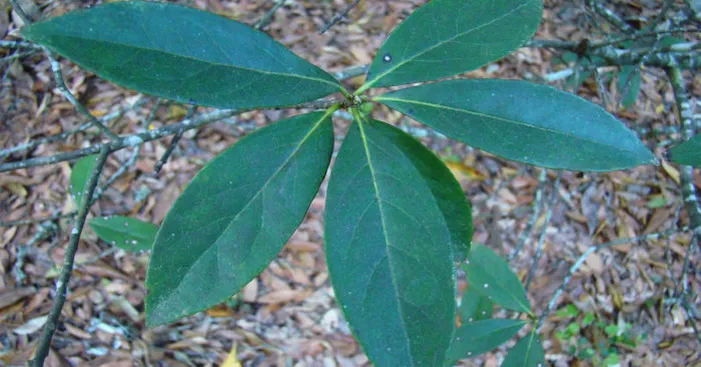Table of Contents

Sweet Leaf is an herb that has been used for centuries in traditional medicine and is now gaining popularity for its myriad of health benefits.
It has a sweet, floral flavor and is often used in teas, smoothies, and other beverages.
From boosting energy levels to aiding digestion, Sweet Leaf has numerous health benefits that make it a great addition to any diet.
Read on to learn more about this amazing herb and how it can help you stay healthy and happy!
Sweet leaf shrub: overview

Sweet leaf is an American herb known for its rich nutritional composition and is used in cosmetics, drinks, and recipes.
The tree of the sweet leaf is native to the North American continent but it has many cousin plants, especially in Southeast Asia.
Because of the lack of information on American sweet leaf shrubs, we are going to refer to their Asian cousins whenever it’s needed.
Sweet leaf shrub is a very useful vegetable that grows all across Noth America and Asia.
Scientifically, the plant goes by the name “Symplocos Tinctoria” and it’s a tree that grows up to 18 ft (6m).
There are very similar characteristics between sweet leaves and their cousin plants from Asian origins including the famous katuk leaves.
Even though katuk leaves come from the Sauropus androgynus tree, they still share similar nutritional composition.
The leaves of such plants have pointed edges and the flowers are yellow, small, and very fragrant.
Also, the plant is very resistant and can be grown in small gardens and small pots on the balcony, like basil.
Since ancient times, Asians knew about medicinal plants and used them in their traditional medicine.
What makes Asian teas, infusions, and remedies very beneficial is the fact that each of them has been empirically tested.
The knowledge of such experiences was passed from the ancestors and most of them have been confirmed through modern science.
For instance, sweet leaf have long been used to stimulate breast milk production and lactation.
Sweet leaf nutritional values and health benefits:

Nutritional values:
The sweet leaf is full of many essential nutrients including vitamins A, C, and B9 as well as carotenoids and antioxidants.
Among the many antioxidants in this plant, it is particularly rich in kaempferol, quercetin, and glycoside elements.
Also, these leaves are a good source of protein as they offer more than 5g per 100g.
Since they are plant-based, these leaves are also a great source of dietary fiber and minerals.
Health benefits:

Fights inflammation:
Even though always linked with sickness and poor health, inflammation is the natural response to an injury or infection.
The body focuses its energy on the injured or infected part and usually succeeds in just a few days.
Nonetheless, some inflammations may last longer and can even increase the risk of cancer and heart disease.
This is where sweet leaf may come in handy as it offers great anti-inflammatory properties.
In fact, it contains many anti-inflammatory substances including steroids, alkaloids, saponin, terpenoids, triterpenoids, and tannins.
Stimulates lactation:
After giving birth, the woman’s body experiences increased levels of hormones like oxytocin and prolactin.
These hormones increase breast milk production by stimulating the mammary alveoli to absorb more fats, sugar, and protein.
In this sense, the sweet leaf is very commonly used in traditional medicine worldwide because it enhances lactation.
This is also backed by science as recent studies proved that sweet leaf increased milk production for breastfeeding rats.
In fact, the sweet leaf is a good source of vitamin A which reacts with fatty acids and triggers the release of prolactin.
This hormone then stimulates the development of glands in the interlobular tract which are used for milk secretion.
However, to improve lactation the mother needs to have a balanced diet that provides all the nutritional needs.
This includes: getting enough hours of sleep, drinking enough water, and meeting the daily requirements in essential nutrients while experiencing minimum stress.
Speeds up wound healing:
The sweet leaf is full of antioxidant properties which can eradicate free radicals which can accelerate wound healing.
For instance, the sweet leaf contains vitamin C which can stimulate the production of collagen, the basic skin-building protein.
When we get a bruise or an injury, the outer layer of our skin is usually damaged which makes the blood exposed to the air.
Once we consume sweet leaf, it offers vitamin C and other anti-oxidants which goes through the bloodstream to the wound.
Once they reach the injured skin, they sterilize the wound and promote the development of new skin to speed up the healing process.
Offers anti-infection properties:
Sweet leaf can also prevent infections thanks to its antibacterial properties.
We all have essential bacteria that live in our intestines, skin, private areas, and nose.
Among these bacteria, we have Staphylococcus aureus and Klebsiella pneumonia which live in the nose and intestines.
An animal study on rats confirmed that ethanol extract from sweet leaf may be able to inhibit the growth of such bacteria.
Under certain conditions, these two bacteria can get out of control and cause bacteremia and pneumonia.
Consuming sweet leaf will provide anti-infection properties that can prevent such infections.
Helps lose weight:
According to the World Health Organization, more than 1 billion worldwide suffer from obesity.
This condition is very critical to health as it increases the risks of various chronic diseases including cancers, diabetes, and heart disease.
The sweet leaf shrub is very low in fats and calories which doesn’t promote weight gain and still provides essential nutrients.
For instance, it is a good source of fiber and flavonoids which promotes satiety and suppress hunger.
If you want to reduce this risk you need to include more green vegetables in your diets such as lettuce, spinach, cabbage, and sweet leaf.
A natural aphrodisiac:
These leaves contain a lot of phytochemicals that can enhance sperm quality and sexual performance.
In fact, a study on rabbits shows that sweet leaf content can be effective as a natural sexual stimulant to increase sexuality.
Not only phytochemicals, but these aphrodisiac properties of the sweet leaf also come from alkaloids and flavonoids.
Several types of research show that these compounds combined with exercise can treat erectile dysfunction and increase testosterone levels.
Good during pregnancy:
Every pregnant woman naturally expects to have a healthy optimal baby after waiting for several months.
Unfortunately, 3% of newborn babies in the United States each year are born with a defect.
To reduce such risks, the mother needs to ensure she is maintaining a good diet by ingesting enough nutrients.
According to studies, the mother’s nutrition and protein intake in particular are crucial to embryonic growth, development, and survival.
As part of a healthy diet, the sweet leaf can prevent certain proteins that are good for the development of the fetus’s brain.
For instance, the plant-based high protein content of sweet leaf is more than 10 times more than that of spinach or mushrooms, or corn.
On the opposite, having a low protein intake may increase the risks of underdevelopment and post-birth undergrowth.
Other health benefits:
- Reduces the risk of anemia.
- Maintains bone health.
- Prevents osteoporosis.
- Increases energy and stamina.
- Improves eye health.
- Increases sperm production.
- Prevents cancer.
- Regulates blood pressure.
- Reduces the risk of diabetes.
Precautions before you consume sweet leaf:

The sweet leaf is like any other type of food or drinks we ingest, with overconsumption comes side effects.
Here are some of the side effects that sweet leaf can cause:
- Shortness of breath.
- Difficulty sleeping.
- Loss of appetite.
- Can lead to respiratory tract infection.
- Loss of appetite.
In addition, the sweet leaf contains papaverine, which is the same alkaloid found in opium and can cause poisoning if consumed excessively.
You should also know that sweet leaf shrub contains toxic substances that can be harmful to health.
These toxic substances are mostly present in the young and raw sweet leaves which is why we should avoid consuming them raw.
The overconsuming of such herbs may sound rare but don’t forget that we use them to make infusions, salads, and many cooking recipes.
In fact, a study on 115 Americans with bronchiolitis found that in 110 of them it was due to regular consumption of sweet leaf.
However, don’t be afraid of consuming sweet leaf as it still offers many health benefits and there are tips to reduce the risks.
For instance, we can minimize the risks of such toxic components by boiling the leaves before using them.
Also, make sure you wash the leaves well with tap water for at least 3 to 4 minutes to ensure that all the surface toxins are washed off.
Using sweet leaf:
There are many ways in which you can use a sweet leaf as it can be used as a flavor enhancer in most food recipes.
You can cook them with rice, lentils, and many other Asian recipes including dumplings.
Also, you can fry sweet leaves and use them as a garnish for meats and fish.
Here’s a sweet leaf recipe that you can make at home:
Sweet leaf omelet:

Ingredients:
- 2 eggs.
- 2 bay leaves.
- 5 to 7 sweet leaves.
- 2 red peppers (sliced).
- ½ cup of coconut milk (150ml).
- 3 tbsps of corn oil.
- 2 cloves of garlic (chopped finely).
- Salt & pepper.
Preparation:
- Heat corn oil in a frying pan then fries the red pepper slices with garlic, sweet leaves, and bay leaves.
- Add coconut milk to the frying pan and stir for a bit.
- Let them cook and in the meanwhile beat the eggs with salt and pepper.
- Add the eggs to the coconut sauce and stir for a while then take the pan off the oven.
Indonesian vegetable broth:

Ingredients:
- 2 cups of water.
- 5 to 7 sweet leaves.
- 2 bay leaves.
- 1 carrot.
- 2 medium-sized onions.
- 1 cob of corn.
- Salt & pepper.
Preparation:
- First of all, start by washing the corn, the bay leaves, and the sweet leaves then drain them.
- Now slice the sweet leaves finely, the onions into small pieces, and chop the carrot into round pieces to make it easy to cook.
- Peel the corn cob and separate the corn kernels.
- In a large pot, heat the water with corn kernels, chopped onion, and bay leaves, and let it boil while stirring from time to time.
- Once the water boils, add the round pieces of carrots and cook until they become tender.
- Add the finely chopped sweet leaves and let them cook for 3 more minutes.
- Season with salt and pepper and enjoy this yummy clear vegetable soup with your loved ones!
Final thoughts:
The sweet leaf is a type of herb very rich in nutrients and can be used similarly to parsley, basil, spinach, oreganos…
Extract of these leaves is used in many cosmetic products, healthy drinks, and pharmaceutical drugs.
It is known for its strong antioxidant effects and richness in vitamins A, B, and C as well as minerals such as potassium and magnesium.
Because of such nutritional richness, the sweet leaf can protect us from inflammation, it can protect us from infections, and even act as a natural aphrodisiac.
